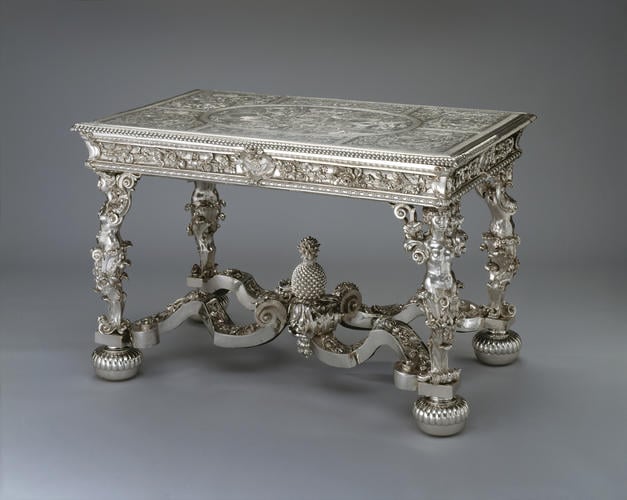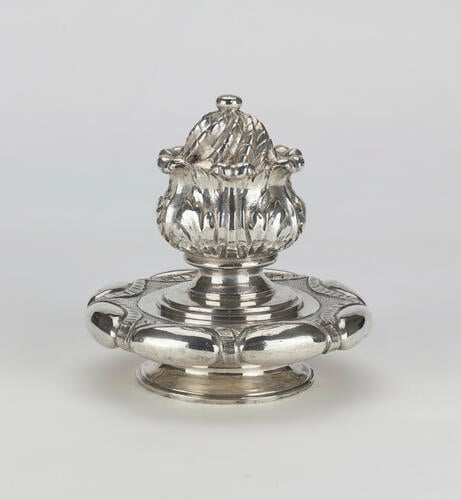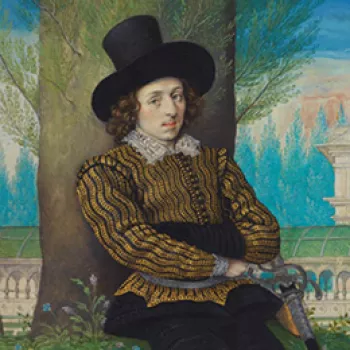Side table 1698-99
Silver and oak | 85.0 x 122.0 x 75.5 cm (whole object) | RCIN 35301
-
This table is one of the most magnificent surviving examples of the fashion for silver furniture, which spread to England from the court of Louis XIV at Versailles, during the reigns of the later Stuart monarchs. Its solid silver legs support an oak tabletop, overlaid with thick sheets of silver, bearing the marks of Andrew Moore (1640–1706), a silversmith from Bridewell in the City of London. The table is thought to have been made to a design by Daniel Marot (1661–1752), who also worked as a garden designer for William III at Hampton Court Palace.
On his accession in 1760 George III inherited three late seventeenth-century suites of silver tables, mirrors and stands. These had been displayed in the State rooms in Windsor Castle since the reign of Queen Anne and in the early years of the King’s reign they were regularly cleaned and repaired. A further set was in the collection of Frederick, Prince of Wales, at Leicester House in the 1740s. These were the remnants of far larger suites of silver furnishings, which had been displayed throughout the royal palaces during the reigns of the later Stuarts. The popularity of silver furnishings had however diminished in the first half of the eighteenth century and in February 1764 ‘three silver tables and six stands’, together with numerous old sconces, chandeliers and firedogs ‘which are not English Standard’, were ‘Delivered to be melted...to be reduced into English Sterling to complete his Majesty’s Gift of 8000oz of old Plate to the Duke of Gloucester’ - part of a generous gift for the King’s third brother, Prince William, Duke of Gloucester.
Thereafter the three sets disappear from the Jewel House records. However in February 1805 an account of ‘their Majesties’ Fete at Windsor Castle’ noted ‘the novel and grand appearance of four silver tables, between each window [in the Queen’s Ballroom]. The magnificent effect of the tables was considerably heightened by four most elegant pier glasses over each with silver frames’. In addition five silver chandeliers were hung in the Ballroom and the Queen’s Drawing Room next door.
This magnificent arrangement was recorded in a view of the Queen’s Ballroom in 1817. It would therefore appear that elements of at least two of the sets of silver tables, mirrors and stands were spared the melting pot in 1764. One composite surviving set includes two stands, a table and a mirror decorated with the cipher of Charles II. This table belongs to a set including mirror and stands (the latter now missing) made for William III in 1699. It would therefore appear that by 1805 George III had had a change of heart, and that these examples of high baroque furnishings were now deemed suitable for his newly refurbished apartments at Windsor Castle.
The pineapple may simply have been included as a newly cultivated, valuable fruit of shapely form, which was often associated with hospitality and welcome. It was also a more exotic version of the traditional pine-cone form popular with silversmiths, particularly in Germany, from the beginning of the seventeenth century. But it may have been intended to suggest Dutch supremacy over the French in more than purely horticultural terms. At the point when William III commissioned this table, he had recently concluded a treaty that had brought to an end the war between England and France, and had forced Louis XIV to recognise William III as the rightful king of England. The wars had been so costly that in 1689 the French king had been forced to melt down his own silver furniture to pay for them. For William, the satisfaction of commissioning his own silver furniture, and of placing a pineapple, a fruit of the sun, and possibly a reference to the ‘Sun King’, underneath the table at the crossing point of the stretchers (a position that was often left empty in contemporary wooden tables of the same form) must have been intense.
The casting of a plant native to South America in silver mined and imported from that continent was not to be repeated, as the fashion for silver furniture was already in decline. When the pineapple later reappeared in decorative form, it was most often found on tableware.
Struck with the maker’s mark of Andrew Moore; the top engraved HR. Sculp
Catalogue entry adapted from George III & Queen Charlotte: Patronage, Collecting and Court Taste, London, 2004 and Painting Paradise: The Art of the Garden, London, 2015.Provenance
Part of a suite of furnishings commissioned by William III for Kensington Palace in 1698 and delivered in 1699
-
Creator(s)
(silversmith)(nationality)Acquirer(s)
-
Medium and techniques
Silver and oak
Measurements
85.0 x 122.0 x 75.5 cm (whole object)
Category
Object type(s)
Other number(s)
Laking FR : Laking, G.F., 1905. The Furniture of Windsor Castle, London – Laking FR p29,pl.9















